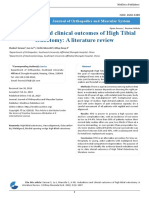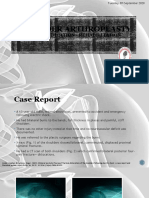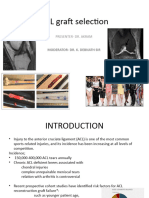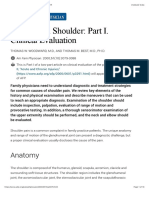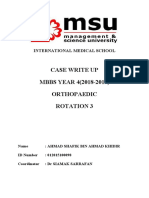Dr. A. Samy TAG Surgical Approaches - 1
Dr. A. Samy TAG Surgical Approaches - 1
Uploaded by
gehadbeddaCopyright:
Available Formats
Dr. A. Samy TAG Surgical Approaches - 1
Dr. A. Samy TAG Surgical Approaches - 1
Uploaded by
gehadbeddaOriginal Title
Copyright
Available Formats
Share this document
Did you find this document useful?
Is this content inappropriate?
Copyright:
Available Formats
Dr. A. Samy TAG Surgical Approaches - 1
Dr. A. Samy TAG Surgical Approaches - 1
Uploaded by
gehadbeddaCopyright:
Available Formats
Surgical Approaches
Shoulder
Anterior (Deltopectoral) Anterolateral Lateral (Deltoid Splitting) Posterior
- Proximal humerus #s - Proximal humerus #-dislocations
- Rotator cuff repair
- Long head of í biceps injury - Proximal humerus #s - Glenoid #s/osteotomy
- Repair of í long head of í biceps
Indication - Reconstruction of recurrent dislocations - Rotator cuff repair - Scapular neck #s
- AC joint decompression
- Septic glenohumeral joint - Debridement of í subacromial space - Septic glenohumeral joint
- Anterior shoulder decompression
- Shoulder arthroplasty - Removal loose bodies
- Standard: Supine - Standard: Supine - Standard: Prone
Position - Beach-chair
- Alternative: Beach-chair - Alternative: Beach-chair - Alternative: Lateral, Beach-chair
- 10-15 cm incision following í line of í
deltopectoral groove - Incision is made from í coracoid process - 5 cm incision is made from í tip of í acromion - Incision is made along í scapular spine,
Incision
- In obese patients, í incision starts at í along í anterolateral edge of í shoulder. distally in line é í arm extending to í lateral acromial border
coracoid process
- No internervous plane - No internervous plane
Intervals - Between í Deltoid & Pectoralis major - Between í Teres minor & Infraspinatus
- Deltoid split proximally to í axillary n. - Deltoid is split in line é its fibers
- Musculocutaneous n.: renters medial side of
- Axillary n.: It runs transversely across í
biceps muscle 5-8 cm distal to coracoid (stay - Axillary n.: It runs transversely across í - Suprascapular n.: Passes around í base of í
surface of í deltoid muscle 5-7 cm distal to í
lateral) surface of í deltoid muscle 5-7 cm distal to í scapular spine (do not retract infraspinatus
acromion from posterior to anterior
- Cephalic vein acromion from posterior to anterior too vigorously)
Dangers - Cannot extend split further due to risk to
- Axillary n.: at risk é release of subscapularis - Acromial branch of í thoracoacromial artery: - Axillary n.: Runs through í quadrangular
denervation of anterior deltoid, if distal
tendon or é incision of teres major tendon or Runs directly under í deltoid muscle space beneath í teres minor (Stay superior to
extension is needed make a 2nd incision
latissimus dorsi tendon í teres minor)
distally
- Anterior circumflex humeral artery
Dr. A. Samy TAG Surgical Approaches | 1
Arm
Anterior (Brachialis Splitting) Anterolateral Approach to Distal Humerus Lateral Approach to Distal Humerus Posterior
- Humeral shaft #s - Humeral shaft #s (More cosmetic)
- Humeral shaft #s - Distal humeral #s (Lateral condyle)
Indication - Humeral tumor biopsy/resection - Provides good exposure to both middle &
- Radial n. exploration - Open treatment of Lateral epicondylitis
- Humeral osteotomy distal 1/3 humeral shaft #s
- Prone é arm on arm-board, abducted 45°-60°
Position - Supine é arm on arm-board, abducted 45°-60° - Supine é arm lying across chest
- Lateral é arm over í top of í body
- Curved incision from í tip of í coracoid process distally in line é deltopectoral groove along í
lateral border of í biceps - Curved or straight incision over í lateral - Incision from 8 cm distal to í acromion to í
Incision
- Incision should end approximately 5 cm short of elbow flexion crease (Lateral antebrachial Supracondylar ridge olecranon fossa
cutaneous n. at risk)
- Proximal: Deltoid & Pectoralis major - No internervous plane - No internervous plane - No internervous plane
Intervals
- Distal: Medial brachialis & lateral brachialis - Between í Brachialis & Brachioradialis - Between í Triceps & Brachioradialis - This is a muscle splitting approach
- Anterior circumflex humeral artery:
- Lateral Cutaneous n. of í forearm: At í distal
Proximally ( ) í Pectoralis major & Deltoid
end of í incision as it exits í biceps laterally - Radial n.: On í middle 1/3 of í humerus
- Axillary n.: é vigorous retraction of í deltoid
- Radial n.: On í middle 1/3 of í humerus where - Radial n.: é proximal extension, as í n. pierces where it lays in í spiral groove (Must be
Dangers - Radial n.: On í middle 1/3 of í humerus where
it lays in í spiral groove (Must be identified í lateral septum in í distal 1/3 of í arm identified before brachialis muscle incision or
it lays in í spiral groove (Must be identified
before brachialis muscle incision or periosteal elevation)
before brachialis muscle incision or
periosteal elevation)
periosteal elevation)
Dr. A. Samy TAG Surgical Approaches | 2
Elbow
Posterior Anterolateral Medial Lateral (Radial Head)
- Distal biceps avulsion
- ORIF of #s of í distal humerus - Ulnar n. Decompression &/or transposition - Management of pathologies of í radial head
- Neural compressions involving:
- Best intra-articular view of í elbow - Ulnar removal of loose bodies - ORIF
- PIN syndrome
- Removal of loose bodies - ORIF of í Ulnar coronoid process - Radial head excision
Indications - Radial tunnel syndrome
- Non-unions of í distal humerus - ORIF of í Medial condyle & epicondyle - Radial head replacement
- Superficial radial nerves
- Triceps lengthening for extension - Debridement & reattachment of common - LCL reconstruction or repair
- Total elbow replacements
contractures of í elbow flexor wad for medial epicondylitis - Management of coronoid #s (limited access)
- Surgery of capitellum
- Supine é upper extremity supported on
- Prone or lateral decubitus é elbow flexed & - Supine é arm flexed & supported by arm patient's trunk & forearm pronated
Position - Supine é arm on radiolucent arm board
arm hanging from side of table board over í patient - Lateral decubitus é arm supported over a
bolster & forearm pronated
- Begin 5cm proximal to í olecranon in í
midline of í posterior distal humerus - Make curved incision starting 5 cm proximal
- Curve laterally proximal to í tip of í of í to flexion crease along í lateral border of í - Curved incision 8 to 10 cm long on í medial - 5cm longitudinal or gently curved incision
Incision olecranon along í lateral aspect of í biceps aspect of í elbow centered over í medial based off í lateral epicondyle & extending
olecranon process - Continue distally by following medial border epicondyle distally over í radial head approximately
- Then curve medially over í middle of í of í brachioradialis
posterior aspect of í subcutaneous ulna
- No internervous plane
- Proximal: ( ) Brachioradialis (radial n.) & - Proximal: ( ) Brachialis (musculocutaneous
- Extensor mechanism is either split or
Brachialis (Musculocutaneous n.) n.) & Triceps (radial n.) - Anconeus (radial n.) & Extensor carpi ulnaris
Intervals detached
- Distal: ( ) Brachioradialis (radial n.) & - Distal: ( ) Brachialis (musculocutaneous n.) (posterior interosseous n.)
- Radial n. innervates í triceps muscle more
Pronator teres (median n.) & Pronator teres (median n.)
proximally
- Lateral antebrachial cutaneous n. of í
- Ulnar n.: can usually be palpated 2cm
forearm: must incise skin & subcutaneous
proximal to medial epicondyle - Posterior Interosseous n.: not in danger as
tissues carefully - Ulnar n.: at risk during approach. must be
- Median n.: strict subperiosteal dissection off long as dissection remains proximal to
- Radial nerve dissected out to ensure protection
í anterior surface of í humerus protects it annular ligament. release supinator along
- PIN: vulnerable as it winds around í neck of í - Median n.: aggressive traction on í
Dangers - Radial n.: at risk proximally as it travels from posterior radius border beyond annular
radius éin í substance of í supinator muscle. osteotomy fragment can cause a traction
í posterior to anterior brachial ligament é forearm in full pronation
Incise í supinator muscle at its origin é injury to í median & anterior interosseous
compartments through lateral - Radial n.: not in danger as long as elbow
forearm supinated to protect í nerve. nerves
intermuscular septum. joint is entered laterally & not anteriorly
- Recurrent branch of í radial artery: must be
- Brachial artery: runs é í median n.
ligated to mobilize í brachioradialis
Dr. A. Samy TAG Surgical Approaches | 3
Forearm
Anterior Approach to Radius (Henry) Posterolateral Approach to Radius (Thompson) Subcutaneous Approach to Ulnar Shaft
- ORIF of proximal radius & radial shaft #s - ORIF of radial shaft #s using extensor side
- ORIF of ulnar #s
- Radial osteotomy - Radial osteotomy
- Ulnar osteotomy
- Tumor/abscess biopsy & excision - Osteomyelitis & Bone tumor resection/biopsy
Indications - Ulnar lengthening (Kienbock's disease)
- Anterior exposure of bicipital tuberosity - Access to í PIN as it passes through í arcade of Frohse for n.
- Ulnar shortening (for radial malunion)
- Superficial radial n. compression syndrome (Wartenberg paralysis
- Osteomyelitis & tumors of ulna
Syndrome) - Resistant Tennis elbow
- Patient supine
- if arm is abducted to í side on an arm board, í forearm
- Patient supine é arm placed across chest or elbow flexed
Position - Patient supine é í arm supinated on armboard should be pronated
while surgical assistant holds forearm vertically
- if arm is adducted across í chest, í forearm should be
supinated
- Straight or gently curved incision along í dorsolateral aspect
of í forearm
- Longitudinal incision begin just lateral to biceps tendon on flexor - Linear longitudinal incision over subcutaneous border of ulna
Incision - Begin anterior & distal to í lateral epicondyle of í humerus &
crease of elbow & end at radial styloid process (length based on procedure)
end just distal & ulnar to Lister's tubercle
- Be aware of superficial radial n. & cephalic vein distally
- Proximal: Brachioradialis (radial n.) & Pronator teres (median n.) - Proximal: ECRB (radial n.) & EDC (PIN n.)
Intervals - ECU (PIN) & FCU (ulnar n.)
- Distal: Brachioradialis (radial n.) & FCR (median n.) - Distal: ECRB (radial n.) & EPL (PIN n.)
- PIN.: enters í supinator muscle beneath a fibrous arch known as í
arcade of Frohse (thickened edge of í superficial head of í
- PIN.: usually from retraction, plates placed high on í dorsal
supinator muscle) compression of í n. at this point causes PIN - Ulnar n. & artery: Proximally passes through 2 heads of FCU
surface may trap í nerve
Dangers entrapment syndrome travels down forearm under FCU & on top of FDP
- Posterior interosseous artery: accompanies í PIN along í
- Superficial radial n.: runs down forearm under body of - protect by dissecting FCU subperiosteally
interosseous membrane in í proximal 1/3 of radius
brachioradialis
- Radial artery: runs down middle of forearm under brachioradialis
Dr. A. Samy TAG Surgical Approaches | 4
Wrist
Volar Approach to í Wrist FCR Approach to Distal Radius Dorsal Approach to í Wrist
- ORIF of distal radius #s
- Decompression of median nerve
- ORIF of carpal #s & dislocations
- Flexor tendon synovectomy
- Synovectomy & repair of extensor tendons
- Carpal tunnel tumor excision
- ORIF of distal radius #s - Wrist fusion
Indications - Carpal tunnel nerve & tendon repair
- ORIF of carpus #s - PIN neurectomy
- Drainage of sepsis from í mid-palmar space
- Excision of lower end of radius
- ORIF of #s & dislocations of distal radius & carpus especially
- Proximal row carpectomy
volar lip intra-articular #s
- Proximal pole scaphoid #
- Patient supine é í arm supinated on armboard é palm facing
Position - Patient supine é í arm supinated on armboard - Patient supine é í arm pronated on armboard
up
- Incision just ulnar to í thenar crease in hand & medial to
palmaris longus in wrist - Incision along palpable flexor carpi radialis (FCR) tendon
Incision - Begin 4cm distal to flexion crease, make ulnar curve so you sheath make ulnar or radial curve so you don't cross - 8 cm incision halfway ( ) radial & ulnar styloid
don't cross perpendicular to flexion crease (protect palmar perpendicular to flexion crease
cutaneous branch), end 3 cm proximal to flexion crease
- No internervous plane
- No muscles are transected
- APB, Palmaris brevis fibers that cross í midline can
Intervals - Flexor carpi radialis (median n.) & Flexor pollicis longus (AIN) - Dissection carried out ( ) í 3rd & 4th extensor compartments
occassionally be dissected
- Major nerves dissected out & preserved
- Plane of dissection ( ) median n. & FCR
- Palmar cutaneous branch of median n.: arises 5 cm proximal
to wrist joint, runs ulnar to FCR before crossing flexor - Superficial radial n.: emerges from beneath brachioradialis
- Palmar cutaneous branch of median n.: arises 5 cm proximal
retinaculum (Greatest risk when you do not curve your tendon just above í wrist joint before traveling to dorsum of í
to wrist joint, runs ulnar to FCR
incision ulnar) hand
- Radial artery.
Dangers - Motor branch of median n.: risk to n. minimized if incision - Dorsal cutaneous branches: lie in subcutaneous fat
- Volar wrist capsule ligaments: do not remove from volar
through retinaculum made ulnar to median nerve - Radial artery
distal radius unless access to wrist joint is needed (lead to
- Superficial palmar arch: crosses palm at level of distal end of - Interosseous ligaments: can cause carpal instability
radiocarpal instability)
outstretched thumb, avoid injury if retinaculum cut under - Scaphoid devascularization
direct observation for its entire length
Dr. A. Samy TAG Surgical Approaches | 5
Acetabulum
Posterior Approach (Kocher-Langenbeck) Ilioinguinal Approach Extensile (Extended iliofemoral) Approach
- Posterior wall #s - Transtectal transverse # é roof impaction
- Anterior wall #
- Posterior column #s - Transverse é posterior wall #s
- Anterior column #
- Posterior column/posterior wall #s - T--shaped #s é posterior wall involvement
- Anterior column/posterior hemitranverse #
- Transverse (Juxtatectal, infratectal or é posterior wall) #s - T-shaped #s é pubic symphysis dislocation
- Transverse # if displacement is anterior
Indications - Some T-type #s - Both-column #s é posterior wall or posterior column
- Majority of associated Both-column #s even in presence of
- THA & Hip hemiarthroplasty comminution, SI joint involvement,
posterior wall # (not recommended for #s associated é
- Removal of loose bodies - Delayed fixation of both column, T-shaped, or transverse +
comminuted post wall #s or SI joint #s)
- Dependant drainage of septic hip posterior wall #s (> 3 wks)
- Minimally posteriorly displaced T-type #s
- Pedicle bone grafting - Malunion/nonunion/deformity correction
- Entire posterior column - Sacroiliac joint - External aspect of í ilium
- Greater & lesser sciatic notches - Internal iliac fossa - Anterior column as far as í
- Ischial spine - Pelvic brim iliopectineal eminence
Access:
- Retroacetabular surface - Quadrilateral surface - Posterior column as far as í
- Ischial tuberosity - Superior pubic ramus upper ischial tuberosity
- Ischiopubic ramus - Limited to external iliac wing
- Lateral position: for joint arthroplasty (allows for femoral
- Supine é greater trochanter on side of # at edge of table
head dislocation)
Position - Hip & knee are flexed to relax í ilipsoas & neurovascular - Lateral position
- Prone position: for transverse # (flex í knee to prevent
structures
stretching of sciatic n.)
- Longitudinal incision centered over greater trochanter start - Incision begins at midline 3-4cm proximal to symphysis - Incision is carried along í iliac crest starting from í PSIS &
Incision just below iliac crest, lateral to PSIS, extend to 10 cm pubis, proceeds laterally to ASIS, then along anterior 2/3 of running anteriorly to í ASIS, it is then continued down from í
below tip of greater trochanter iliac crest ASIS in line é í posterior femur
- Sciatic n.: initially located along posterior surface of - Femoral n., Femoral & External Iliac Arteries: protect by - Superior gluteal artery & vein
quadratus femoris muscle (extend hip & flex knee to prevent leaving in femoral sheath - Sciatic nerve
injury), minimize chance of injury by using proper gentle - Lymphatics: present in fatty areolar tissue around vessels, - Lateral femoral cutaneous n.
retraction & releasing your short external rotators (obturator disruption can impair postoperative lymphatic drainage & - Perforating branches of í femoral artery
internus) posteriorly to protect í sciatic n. from traction, treat cause edema - Heterotopic Ossification : highest rate of heterotopic bone
injury é observation & use of ankle-foot orthosis - Lateral cutaneous n. of thigh: often have to sacrifice leaving formation of all pelvic approaches
- Inferior gluteal artery: leaves pelvis beneath piriformis, if it is numbness on í outer side of í thigh
cut & retracts into í pelvis, then treat by flipping patient, - Inferior epigastic artery: must sacrifice if has anomoulous
open abdomen & tie off internal iliac artery origin off obturator artery to allow retraction of iliac vessels
- First perforating branch of profunda femoris: at risk of injury - Spermatic cord: must protect, damage can cause testicular
é release of gluteus maximus insertion ischemia, infertility
Dangers
- Femoral vessels: at risk é failure to protect anterior aspect of - Heterotopic Ossification: much more common in í extended
í acetabulum or é placement of retractors anterior to í iliofemoral & Kocher-Lagenbeck approaches
iliopsoas muscle - Obturator n.: causes medial thigh numbness when injured
- Superior gluteal artery & n.: leaves í pelvis above í piriformis
& enters í deep surface of í gluteus medius, this tethering
limits upward retraction of gluteus medius & blocks you from
reaching í iliac crest
- Quadratus femoris: excessive retraction & injury must be
avoided to prevent damage to medial circumflex artery
- Heterotopic Ossification: debride necrotic gluteus minimus
muscle to decrease incidence of HO
Dr. A. Samy TAG Surgical Approaches | 6
Hip
Anterior (Iliofemoral, Smith-Petersen) Anterolateral (Watson-Jones) Direct Lateral (Hardinge, Transgluteal) Posterior (Moore or Southern)
- THA
- THA: minimally invasive approach (no
- DDH - THA
posterior soft tissue disruption)
- Intra-articular fusions - THA: has lower rate of total hip prosthetic - Hemiarthroplasty
- Hemiarthroplasty
Indications - Excision of pelvic tumors dislocations - Removal of loose bodies
- ORIF of femoral neck #
- Pelvic osteotomies - ORIF of proximal femur # - Dependant drainage of septic hip
- Synovial biopsy of hip
- Irrigation & debridement of septic hip - Pedicle bone grafting
- Biopsy of femoral neck
- Synovial biopsy of hip
- Lateral decubitus: for hip arthroplasty
- Lateral decubitus
Position - Supine - Lateral decubitus (Allows for femoral head dislocation)
- Supine
- Prone: for transverse acetabular #s
- Incision starts 2.5 cm posterior & distal to - 10 -15 cm curved incision one inch posterior
- Longitudinal incision begins 5cm proximal to
- Incision from anterior 1/2 of iliac crest to ASIS then runs distal to become centered to posterior edge of greater trochanter
tip of greater trochanter centered over tip of
Incision ASIS & from ASIS curve inferiorly in í over í tip of í greater trochanter, then it - Begin 7 cm above & posterior to GT then
greater trochanter & extends down í line of í
direction of í lateral patella for 8-10 cm crosses posterior 1/3 of trochanter before curve posterior to GT & continue down shaft
femur about 8cm
running down í shaft of femur of femur
- No internervous or Intermuscular plane
- Internervous plane: - No Internervous or Intermuscular plane - Split Gluteus maximus (inferior gluteal
- Superficial: Sartorius (femoral n.) & Tensor - Split Gluteus medius distal to nerve) till í first nerve branch to upper part
- Tensor fasciae latae (superior gluteal nerve)
Intervals fasciae latae (superior gluteal n.) innervation (superior gluteal nerve) & Vastus of muscle is encountered
& Gluteus medius (superior gluteal nerve)
- Deep: Rectus femoris (femoral n.) & lateralis lateral to innervation (femoral - Vascular plane: Superior gluteal artery
Gluteus medius (superior gluteal n.) nerve) supplies proximal 1/3 of muscle & inferior
gluteal artery supplies distal 2/3 of muscle
- Femoral nerve: most common problem is
- Lateral femoral cutaneous nerve: reaches
compression neuropraxia caused by medial - Superior gluteal nerve: runs ( ) gluteus
thigh by passing under inguinal ligament,
retraction, direct injury can occur from medius & minimus 3-5 cm above greater
injury may lead to painful neuroma or
placing retractor into the psoas muscle trochanter, protect by limiting proximal
decrease sensation on lateral aspect of thigh
- Femoral artery & vein: can be damaged by incision of gluteus medius
Dangers - Femoral nerve: remain protected as long as - As Kocher-Langenbeck approach
retractors that penetrate í psoas - Femoral nerve: most lateral structure in
you stay lateral to sartorius muscle
- Abductor limp: caused by trochanteric neurovascular bundle of anterior thigh
- Ascending branch of lateral femoral
osteotomy and/or disruption of abductor - keep retractors on bone é no soft tissue
circumflex artery: found proximally ( ) í
mechanism or denervation of í tensor under to prevent iatrogenic injury
tensor fascia latae & sartorius
fasciae by aggressive muscle split
Dr. A. Samy TAG Surgical Approaches | 7
You might also like
- Alberta Infant Motor Scale RecordsDocument6 pagesAlberta Infant Motor Scale Recordsgrouch12150% (20)
- Yoga The Iyengar WayDocument194 pagesYoga The Iyengar WaySun Morrison Isha100% (32)
- WDSF ST - Waltz - Example PagesDocument5 pagesWDSF ST - Waltz - Example PagesAsyliumNo ratings yet
- Clinical Examination of The Wrist PDFDocument11 pagesClinical Examination of The Wrist PDFAdosotoNo ratings yet
- Taro 2016 ComentadoDocument42 pagesTaro 2016 ComentadoneossmedNo ratings yet
- 30 Days of Training With Mind Pump: Monday Tuesday Wednesday Thursday Friday Saturday SundayDocument1 page30 Days of Training With Mind Pump: Monday Tuesday Wednesday Thursday Friday Saturday Sundayice_coldNo ratings yet
- Spine PDFDocument7 pagesSpine PDFDRAHMEDFAHMYORTHOCLINIC100% (1)
- Indications and Clinical Outcomes of High Tibial Osteotomy A Literature ReviewDocument8 pagesIndications and Clinical Outcomes of High Tibial Osteotomy A Literature ReviewPaul HartingNo ratings yet
- AFO Prescription - Measurement - Casting - Rectification & Fitting ICRCDocument58 pagesAFO Prescription - Measurement - Casting - Rectification & Fitting ICRCEmna Laabidi100% (1)
- Judging Azawakh EnglishDocument9 pagesJudging Azawakh EnglishEliNo ratings yet
- 21 Positioning of Cerebral Palsy ChildDocument8 pages21 Positioning of Cerebral Palsy ChildAdnan RezaNo ratings yet
- Dr. A. Samy TAG Ankle - 1Document4 pagesDr. A. Samy TAG Ankle - 1aatir javaidNo ratings yet
- Dr. A. Samy TAG Upper Limb - 1Document20 pagesDr. A. Samy TAG Upper Limb - 1DRAHMEDFAHMYORTHOCLINICNo ratings yet
- Lumbar Spine Definitions... 2015Document13 pagesLumbar Spine Definitions... 2015aweisgarberNo ratings yet
- X-Ray Views HipDocument1 pageX-Ray Views Hipjuly mirandillaNo ratings yet
- Radial and Ulnar NervesDocument10 pagesRadial and Ulnar NervesZoi Papadatou100% (1)
- 3-9 Anatomy Biomechanics ExtensorDocument31 pages3-9 Anatomy Biomechanics ExtensorProfesseur Christian DumontierNo ratings yet
- Shoulder Arthroplasty: Types - Indication - RehabilitationDocument35 pagesShoulder Arthroplasty: Types - Indication - RehabilitationPerjalanan SukarNo ratings yet
- Amputation: Sites of Amputation: UEDocument6 pagesAmputation: Sites of Amputation: UEChristine PilarNo ratings yet
- The Parachute Technique - Valgus Impaction Osteotomy For Two-Part Fractures of The Surgical Neck of The HumerusDocument5 pagesThe Parachute Technique - Valgus Impaction Osteotomy For Two-Part Fractures of The Surgical Neck of The HumeruslliuyueeNo ratings yet
- Spinal Instrumentatio N: Hanif Andhika WDocument35 pagesSpinal Instrumentatio N: Hanif Andhika WHanifNo ratings yet
- Discoid MeniscusDocument22 pagesDiscoid Meniscusonehipsa0% (1)
- Arthroscopic Ramp Repair No-Implant, Pass, Park, and Tie Technique Using Knee Scorpion, GustaDocument8 pagesArthroscopic Ramp Repair No-Implant, Pass, Park, and Tie Technique Using Knee Scorpion, GustaAlhoi lesley davidsonNo ratings yet
- Achilles Tendon Repair Protocol-PDF-EnDocument2 pagesAchilles Tendon Repair Protocol-PDF-Enckpravin7754No ratings yet
- G11 Ex Fix PrinciplesDocument66 pagesG11 Ex Fix PrinciplesDeep Katyan DeepNo ratings yet
- Ankle AnatomyDocument50 pagesAnkle AnatomyLiao WangNo ratings yet
- Musculoskeletal Cases For Finals: DR Alastair Brown ST1 Neurosurgery CXHDocument38 pagesMusculoskeletal Cases For Finals: DR Alastair Brown ST1 Neurosurgery CXHAravind RaviNo ratings yet
- Guidance and Guideline-Recommendations For The Treatment of Femoral Neck Fractures Romanian Society of Orthopaedics and Traumatology - SOROT 2018Document8 pagesGuidance and Guideline-Recommendations For The Treatment of Femoral Neck Fractures Romanian Society of Orthopaedics and Traumatology - SOROT 2018Feny OktavianaNo ratings yet
- 1 Handout Fedorka Ostrander Ortho Trauma 5.11.18Document52 pages1 Handout Fedorka Ostrander Ortho Trauma 5.11.18Kris ChenNo ratings yet
- Slipped Capital Femoral Epiphysis: Vivek PandeyDocument30 pagesSlipped Capital Femoral Epiphysis: Vivek PandeyvivpanNo ratings yet
- Introduction To OrthopedicsDocument4 pagesIntroduction To OrthopedicsSalman MajidNo ratings yet
- Knee ExaminationDocument7 pagesKnee ExaminationAngy100% (1)
- 1-2 Anatomy-Biomechanics Extensor FESSHDocument45 pages1-2 Anatomy-Biomechanics Extensor FESSHProfesseur Christian Dumontier100% (1)
- Legg Calvé Perthes DiseaseDocument11 pagesLegg Calvé Perthes DiseaseronnyNo ratings yet
- Intervertebral-disc-Anatomy-And PIVD of Lumbar FinalDocument93 pagesIntervertebral-disc-Anatomy-And PIVD of Lumbar FinalShubham RaghavNo ratings yet
- The Leg: - Orthopedic Anatomy - Clinical Anatomy - Radiologic AnatomyDocument50 pagesThe Leg: - Orthopedic Anatomy - Clinical Anatomy - Radiologic Anatomyspeedy.catNo ratings yet
- Acl Graft Selection PPTfinal LatestDocument29 pagesAcl Graft Selection PPTfinal LatestAkram JamiNo ratings yet
- Double-Row, Transosseous-Equivalent Suture-Bridge Repair For Supraspinatus Tears - Power Up The HealingDocument9 pagesDouble-Row, Transosseous-Equivalent Suture-Bridge Repair For Supraspinatus Tears - Power Up The HealingEllan Giulianno FerreiraNo ratings yet
- Spine Disiorders: Departemen Neurologi Fakultas Kedokteran Universitas Sumatera UtaraDocument83 pagesSpine Disiorders: Departemen Neurologi Fakultas Kedokteran Universitas Sumatera UtaraDea indah damayantiNo ratings yet
- Terrible Triad - ElbowDocument96 pagesTerrible Triad - ElbowWasim R. IssaNo ratings yet
- The Painful Shoulder: Part I. Clinical Evaluation - AAFPDocument18 pagesThe Painful Shoulder: Part I. Clinical Evaluation - AAFPMelvin Florens Tania GongaNo ratings yet
- Lower Limb InjuriesDocument47 pagesLower Limb InjuriesDaisyyhyNo ratings yet
- Surgical Incisions of Lower LimbDocument11 pagesSurgical Incisions of Lower LimbcpradheepNo ratings yet
- 1 Principles of Internal Fixation: 1.1.1 Mechanical Properties of BoneDocument29 pages1 Principles of Internal Fixation: 1.1.1 Mechanical Properties of BoneCarlos CalderonNo ratings yet
- Dr. Ankit Gujarathi DMH PuneDocument32 pagesDr. Ankit Gujarathi DMH PuneAnkit GujarathiNo ratings yet
- UE DermatomesDocument1 pageUE DermatomesmdmdegNo ratings yet
- Ankle Foot Orthosis (AFO)Document10 pagesAnkle Foot Orthosis (AFO)aienjalilNo ratings yet
- Biomechanics of KneeDocument78 pagesBiomechanics of KneeDr. Sabari ManokaranNo ratings yet
- Meniscus RepairDocument14 pagesMeniscus Repairapi-547954700No ratings yet
- Lower Limb FracturesDocument124 pagesLower Limb Fracturesmau tau100% (1)
- Salter Harris Classification of Growth Plate FracturesDocument13 pagesSalter Harris Classification of Growth Plate FracturesAarón E. CaríasNo ratings yet
- 3 Column AnkleDocument8 pages3 Column AnkleJosé Eduardo Fernandez RodriguezNo ratings yet
- AO/OTA Fracture and Dislocation Classification: Introduction To The Classification of Long-Bone FracturesDocument13 pagesAO/OTA Fracture and Dislocation Classification: Introduction To The Classification of Long-Bone FracturesWillian OcañaNo ratings yet
- Patellofemoral InstabilityDocument10 pagesPatellofemoral InstabilitysionforjanNo ratings yet
- Ankle Syndesmosis InjuriesDocument16 pagesAnkle Syndesmosis InjuriesRin MaghfirahNo ratings yet
- Principles of Splinting, Casting, & BracingDocument5 pagesPrinciples of Splinting, Casting, & BracingJohn Patrick ShiaNo ratings yet
- Tehnica Sutura Menisc - meniscus-mender-IIDocument8 pagesTehnica Sutura Menisc - meniscus-mender-IIRat MarianNo ratings yet
- Lectures Retrograde NailingDocument21 pagesLectures Retrograde NailingModar AlshaowaNo ratings yet
- Trochanteric #Document20 pagesTrochanteric #Prakash AyyaduraiNo ratings yet
- Clinical Features and Diagnosis of FracturesDocument43 pagesClinical Features and Diagnosis of FracturesChenna Kesava100% (2)
- Clinical Examination of The Knee: DR John EbnezarDocument95 pagesClinical Examination of The Knee: DR John EbnezarsandeepNo ratings yet
- Tendon TransferDocument1 pageTendon TransferPandi Smart VjNo ratings yet
- LimpDocument7 pagesLimpRakesh DudiNo ratings yet
- Fracture Classifications in OrthopaedicsDocument34 pagesFracture Classifications in Orthopaedicshaswal fazry AwalNo ratings yet
- History of Spine InstrumentationDocument35 pagesHistory of Spine InstrumentationSyarifNo ratings yet
- Hip Neck Fracture, A Simple Guide To The Condition, Diagnosis, Treatment And Related ConditionsFrom EverandHip Neck Fracture, A Simple Guide To The Condition, Diagnosis, Treatment And Related ConditionsNo ratings yet
- Muscle Test Summary - 230613 - 232607Document14 pagesMuscle Test Summary - 230613 - 232607عثمان عابدينNo ratings yet
- Effect of Feet Hyperpronation On Pelvic Alignment in A Standing PositionDocument8 pagesEffect of Feet Hyperpronation On Pelvic Alignment in A Standing Positionyayu latifahNo ratings yet
- Biomechanics and Muscular-Activity During Sit-to-Stand TransferDocument11 pagesBiomechanics and Muscular-Activity During Sit-to-Stand TransferAh ZhangNo ratings yet
- The Art of Folk DanceDocument3 pagesThe Art of Folk DanceDianaNo ratings yet
- Satuan Acara Bermain OrigamiiiiiiiiiiiiiDocument14 pagesSatuan Acara Bermain OrigamiiiiiiiiiiiiiatikaNo ratings yet
- How To Squat Cheat SheetDocument4 pagesHow To Squat Cheat SheetAngelNo ratings yet
- Foundation Module Embrology and Gernal Anatomy MCQ by DR of 2027 28Document53 pagesFoundation Module Embrology and Gernal Anatomy MCQ by DR of 2027 28Xandws -IOS tips and trick and gamingNo ratings yet
- Fundamental Movement PatternDocument12 pagesFundamental Movement PatternMa Evangelynne CondeNo ratings yet
- Initial Evaluation General InformationDocument7 pagesInitial Evaluation General InformationJoanna EdenNo ratings yet
- By Saifullah Khalid (Lecturer) School of Physiotherapy, IPM&R, Dow University of Health Sciences, KarachiDocument31 pagesBy Saifullah Khalid (Lecturer) School of Physiotherapy, IPM&R, Dow University of Health Sciences, KarachiAbhinandan RamkrishnanNo ratings yet
- कौमारभृत्य Part ADocument84 pagesकौमारभृत्य Part AShakti S. NamdeoNo ratings yet
- Cools 2008 Screening The Athletes Shoulder ForDocument9 pagesCools 2008 Screening The Athletes Shoulder ForLucyFloresNo ratings yet
- DLL - Mapeh 6 - Q3 - W1Document11 pagesDLL - Mapeh 6 - Q3 - W1Allenly ConcepcionNo ratings yet
- Yoga Positions To Aid FertilityDocument4 pagesYoga Positions To Aid FertilityAdi SetiantoNo ratings yet
- Midterms Reviewer Ana 2Document8 pagesMidterms Reviewer Ana 2Ais WallensteinNo ratings yet
- Functional Re-Education by Kusum-Wps OfficeDocument19 pagesFunctional Re-Education by Kusum-Wps OfficeKusum deep0% (1)
- Powers Et Al 2014 Patellofemoral Joint Stress During Weight Bearing and Non Weight Bearing Quadriceps ExercisesDocument8 pagesPowers Et Al 2014 Patellofemoral Joint Stress During Weight Bearing and Non Weight Bearing Quadriceps ExercisesEduardo FilhoNo ratings yet
- Immobility (Nursing Care)Document7 pagesImmobility (Nursing Care)RANo ratings yet
- Cwu OrhtoDocument15 pagesCwu OrhtoMuhammad HaziqNo ratings yet
- The Neurological Exam: Mental Status ExaminationDocument13 pagesThe Neurological Exam: Mental Status ExaminationShitaljit IromNo ratings yet
- Role of Physiotherapy in Management of Burns-HshDocument25 pagesRole of Physiotherapy in Management of Burns-HshChristopher Chibueze Igbo100% (1)
- Complete Kicking The Ultimate Guide To Kicks For Martial Arts Self-Defense & Combat SportsDocument140 pagesComplete Kicking The Ultimate Guide To Kicks For Martial Arts Self-Defense & Combat SportsXenthoyo Kenth Lee100% (8)
- Deformations and Defects of The Upper and Lower JawsDocument62 pagesDeformations and Defects of The Upper and Lower JawsCarmen Vizarro RodriguezNo ratings yet
- Orif Patella Fracture Rehab ProtocolDocument1 pageOrif Patella Fracture Rehab ProtocolHanna RikaswaniNo ratings yet







